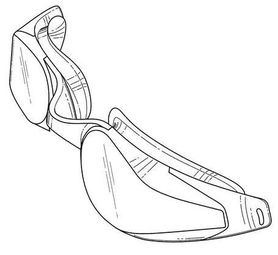 Design patents can be valuable tools to prevent your competitors from copying your innovations and producing counterfeit products or knock-offs. As part of your intellectual property strategy, it might be advisable to protect your innovation with both design and utility patents. What is a design patent? As a lifelong swimmer, I will use this design patent obtained by Roka Sports, Inc. as an illustration of how to successfully use design and utility patent protection. This design patent issued in January 2018 for “Swimming Goggles with Retroscopic Lens.” As you can see from the example, the design patent includes one claim: “The ornamental design for swimming goggles with retroscopic lens, as shown and described.” The scope of the patent is defined by the design illustrated in the 7 figures within the patent. Design patents cover the appearance of an article. This means a design patent can cover the configuration or shape of an article, the surface ornamentation applied to an article, or the combination of configuration and surface ornamentation. To be protectable, the design must be a definite, preconceived thing that is capable of reproduction and not merely the chance result of a method. As I write this blog, over 2,800 design patents have been granted so far in 2018. Some examples of these design patents include: toys, lighting fixtures, faucets, golf clubs, automotive components (wheels, headlights, muffler, dashboards, etc.), cameras, display screens, cases for electronic devices (such as cell phones), tires, audio equipment (including microphones and speakers), jewelry, containers (such as bottles for beverages, floral containers, etc.), tools, and shoes. How is a design patent different from a utility patent? In contrast to the above, utility patents protect the way an article works. Keeping with the swimming goggles example, here is a recent Roka Sports utility patent. As you can see, the subject is swimming goggles with a retroscopic lens, but the description is much more detailed regarding how the goggles are made and used, and there are many detailed claims. The scope of patent protection is defined by the 32 claims of the patent. This Roka Sports example illustrates how you can use both design and utility patents to protect your inventions, so long as your innovation has both functional and ornamental characteristics. Some other main differences between design and utility patents include:
When considering how to protect your innovations, consider whether a design patent might be useful for you. Design patents can provide significant protection along with utility patents, trademark, copyright and trade secret.
0 Comments
 The U.S. Court of Appeals for the 5th Circuit recently considered an entertaining case. Viacom, the owner of the wildly popular “SpongeBob SquarePants” television series, sought to prevent a third party from opening a restaurant under the name “The Krusty Krab.” Krabby Patties, anyone? As millions of people know, Viacom launched the “SpongeBob SquarePants” television series in 1999. Since that time, Viacom has expanded the “SpongeBob” concept into two feature films and a wide variety of licensed products. All of these ventures prominently feature The Krusty Krab fast food restaurant. Notably, prior to the lawsuit in question, Viacom had not sought to register The Krusty Krab as a trademark. In 2014, IJR Capital Investments decided to open seafood restaurants in California and Texas under the name The Krusty Krab. Subsequently, IJR filed a trademark application in the U.S. Trademark Office for THE KRUSTY KRAB. Upon learning of IJR’s trademark application and restaurant plans, Viacom sent a cease and desist letter in November 2015. IJR refused to cease use of The Krusty Krab, and Viacom subsequently filed a lawsuit in January 2016. A central legal question within the case was whether fictional elements of a television show can be protectable trademarks. More specifically, is The Krusty Krab a protectable trademark? As a threshold issue, an important question in the case was whether specific elements from within a television show - as opposed to the title of the show itself – receive trademark protection. In deciding this issue, the court looked to previous decisions from other courts that found protectable trademark rights in Conan (from “Conan the Barbarian”), the General Lee (from “The Dukes of Hazzard”), and the Daily Planet (from “Superman”). In line with these prior decisions, the court concluded fictional elements in entertainment entities can be protected as trademarks. Turning to the Viacom case, the salient question was whether The Krusty Krab mark, as used, will be recognized in itself as an indication of origin for the particular product or service. The mark must create a separate and distinct commercial impression to perform the trademark function of identifying the source. The court concluded that Viacom uses The Krusty Krab as a source identifier and therefore owns the mark. In support of its decision, the court reasoned that the Krusty Krab’s central role in the multibillion-dollar SpongeBob franchise, coupled with the consistent use of the mark on licensed products establishes ownership of the mark because of its immediate recognition as an identifier of Viacom as the source for goods and services. Since filing the lawsuit, Viacom has filed three trademark applications for “KRUSTY KRAB” for some diverse goods/services, such as plastic cake decorations, aquarium ornaments, and providing a website featuring general interest entertainment information related to television programs and cartoons for entertainment purposes. |
AuthorKarrie Weaver practices intellectual property, trademark, patent, and trade secret law. Archives
February 2021
Categories |
612.386.0565
Copyright 2021. Weaver Legal and Consulting LLC. | All rights reserved.
Website by RyTech, LLC
Copyright 2021. Weaver Legal and Consulting LLC. | All rights reserved.
Website by RyTech, LLC

 RSS Feed
RSS Feed